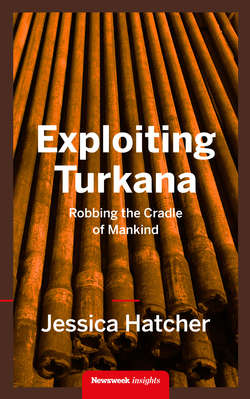Читать книгу Exploiting Turkana - Jessica Hatcher - Страница 6
На сайте Литреса книга снята с продажи.
1 Humanity′s birthplace
ОглавлениеEvery person alive today is related to Turkana Boy’s community
“Turkana Boy” is one of the most complete early human skeletons ever found. A picture based on facial reconstruction makes him look like a morose Shrek, with almost no forehead, ears that sit in-line with his temples, broad cheeks and mouth. Scientists believe that every person alive today is related to Turkana Boy’s community, which lived 1.6m years ago in northern Kenya at the far end of Lake Turkana, where the borders of Kenya and Ethiopia meet.
Despite being one of the world’s richest archaeological treasure troves, Turkana County, where he was found, is the poorest in Kenya, hammered by conflict and crippled by drought. Home to the minority Turkana tribe, its semi-desert land is unproductive, a place where until now few people chose to go. Turkana’s 73,000 square kilometres, almost the size of Ireland, are inhabited by just 880,000 people, according to Kenya’s 2009 census. But that is changing, because the same earth that nurtured human life has fostered another highly-prized commodity: oil.
Turkana Boy’s skeleton now lives 800 kilometres south of where he once roamed the Earth, behind a spot-lit, polished glass cabinet in Nairobi’s National Museum. The museum sits in an oasis of trees behind an Edwardian–style portico under the city’s cloak of smog. Johnson Gitonga is an undergraduate whose holiday job is to steer visitors like me around the museum. Standing beside the skeleton, he tells me he has a plan to claim his share in Kenya’s growing fortunes, which will take him to Turkana Boy’s place of birth. “In Nairobi, everything has been earmarked. There’s nothing left,” he says. “In Turkana, there’s space for expansion and in the next ten years, it’ll be one of the best counties in the country in terms of investment and development.”
Around the museum’s leafy grounds, almost every square metre of land is occupied. A tangle of dual carriageways feed in to the city’s central artery. Barefoot beggars populate the bottleneck junctions, and in between the lines of traffic, hawkers dangle bananas and Chinese electrical goods. A few kilometres up the road is another flagship building. The West End Towers is an imposing glass edifice. At the top of the building’s automated lift shaft lies the head office of Tullow Oil in Kenya.
Nearly 30 years after Turkana Boy was unearthed, this Anglo-Irish exploration company catapulted Turkana into the spotlight once more, when the Kenya government announced Tullow had found oil there in 2012. Within two years, the company has found an estimated 600 million barrels and in January, it claimed there was the potential for drilling more than a billion overall[1]. The discovery bolstered East Africa’s reputation as one of the most prolific oil and gas exploration regions in the world.
While Tullow flanks the museum to the west, to the east over the roundabouts and traffic lights that no one obeys, is another penthouse office suite, where more besuited officials are fashioning a future for Turkana. The Ministry of Energy occupies four floors of Nyayo House. The home of several government institutions, the building became known as a bastion of corruption, where it was impossible to do anything without paying a bribe. Under the 24-year rule of Kenya’s President Moi from 1978 to 2002, some 2,000 Kenyans were held and tortured in the building’s basement, including the former prime minister Raila Odinga. Two administrations later, the torture chambers are now part of a car-park, but Kenya’s struggle with corruption goes on.
In the interests of transparency, Tullow voluntarily disclosed they paid the Kenya government nearly $22m last year in fees[2], as stipulated by their production sharing agreement. The Ministry of Energy says that none of that money went directly to Turkana; it stayed in Nairobi where it went to fund the national budget. Leaders in Turkana say the government is not doing enough for the impoverished county, and have threatened to halt oil exploration if that does not change.
Conflict is brewing, but the impact of oil is not the only concern in Turkana: there are fears that a four-million-year-old lifeline for hundreds of thousands of people is on the brink of ecological collapse. The world’s largest desert lake, Lake Turkana demarcates the county’s eastern boundary. North of it, Ethiopia is building the continent’s largest hydroelectric power project, including the Gilgel Gibe III dam, which could lower Lake Turkana’s water levels and decimate fish stocks[3]. Today, islands made of volcanic craters erupt like giant barnacles from the water’s surface. Part of a UNESCO World Heritage Site, they provide breeding grounds for one of the world’s largest crocodile populations (although their numbers have diminished in recent decades) and food for some two million flamingos who fly in each year. Experts believe the dam could, at best, shrink the lake, at worst, dry it up into two smaller pools, destroying the livelihoods of the quarter million people who rely on the lake[4].
So much hope for development. So much investment. But in the scramble for resources the question is: are we ransacking one of the most historic places on Earth?
1 See the announcement by Tullow Oilhttp://bit.ly/1yyqAQt↵
2 Tullow’s annual reporthttp://bit.ly/1BU3VUp↵
3 See the African Development Bank’s social and environmental assessmenthttp://bit.ly/14WRgSe↵
4 See Sean Avery’s report on the web site of the African Studies Centre, School of Interdisciplinary Area Studies, University of Oxfordhttp://bit.ly/Lk2aYq↵
